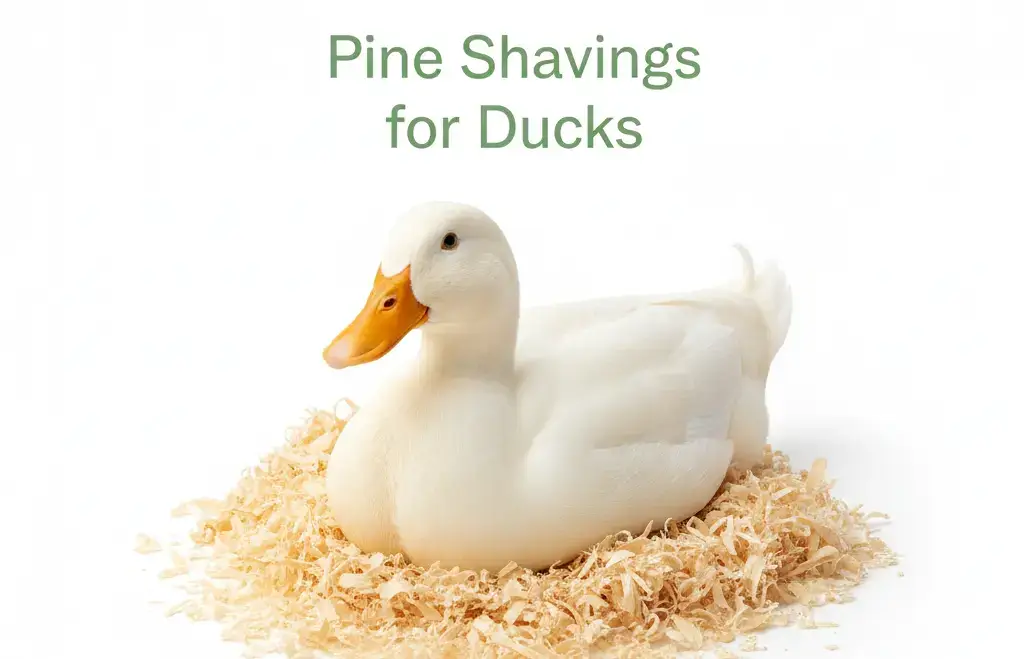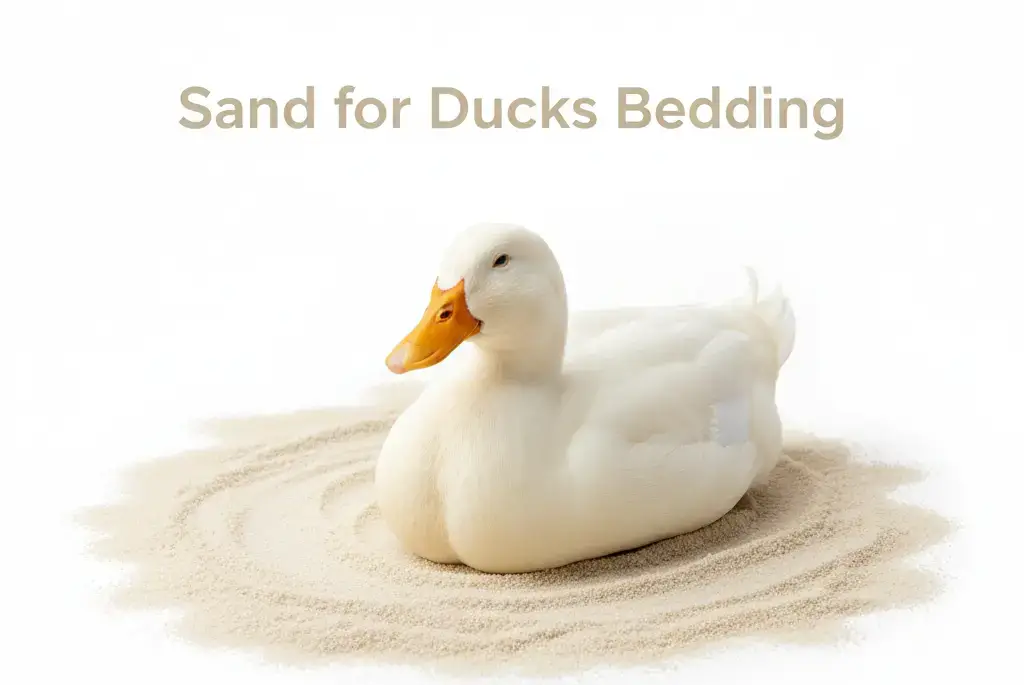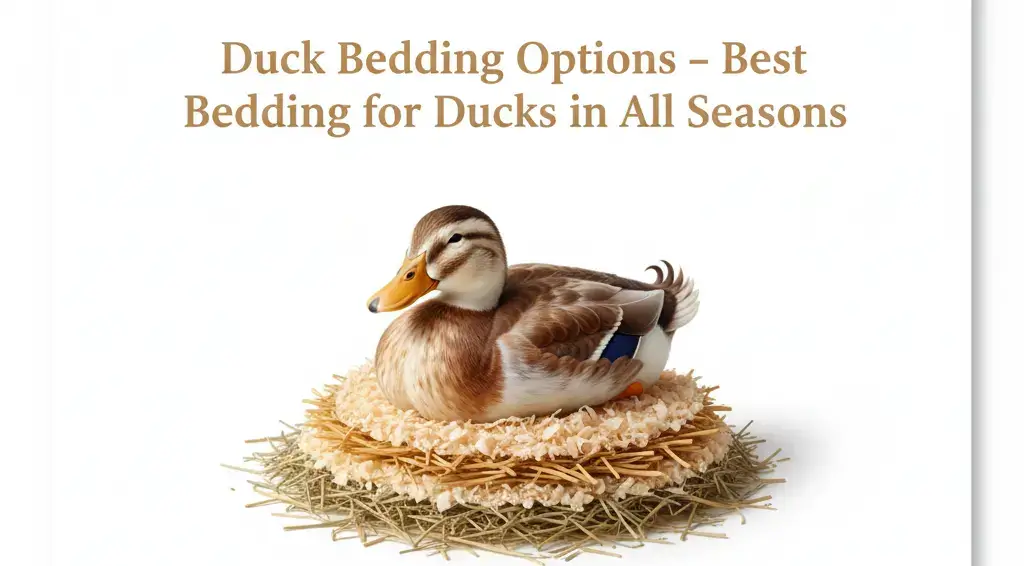Let’s be real. You got ducks. You love them. But you weren’t prepared for the mess. Ducks are wet. They are messy. Their coop can go from clean to a stinking, soggy nightmare in 24 hours. I’ve been there.
The biggest mistake I see new duck owners make is treating their ducks like chickens. They aren’t chickens. Their bedding needs are totally different. Finding the best bedding for ducks isn’t just about comfort; it’s about health.
It’s about stopping that eye-watering ammonia smell. It’s about preventing mold, bacteria, and awful issues like frostbite. So let’s ditch the generic advice and talk about what actually works.
Stop the Stink: Why Duck Bedding is a Totally Different Game
Here’s the problem. Chickens poop. It’s dry. Ducks poop. It’s wet. And ducks don’t just drink water. They play with it. They splash it, dribble it, and try to make a personal pond out of their waterer. This means any bedding you choose is going to get soaked. Wet bedding + duck poop = ammonia. Ammonia is toxic. It burns their respiratory systems and eyes.
Wet, packed-down bedding also breeds mold and bacteria. This can lead to bumblefoot, respiratory infections, and other health issues. So, our goal isn’t just “what duck bedding options are there?” Our goal is to find a system that manages moisture, controls ammonia, and is easy for you to maintain.
The “Big Three” Duck Bedding Options: Pros and Cons
I’ve tried just about everything over the last 30 years. Most advice online just parrots the same three options. But the details are what matter.
Contender #1: Pine Shavings (The Fluffy Staple)

This is the go-to for most poultry. And for ducks, it’s a solid choice.
The Good:
- Super Absorbent: Pine shavings are great at soaking up moisture.
- Good Odor Control: The pine scent helps, but its real power is in trapping moisture.
- Composts Well: It breaks down nicely in the compost pile.
The Bad:
- Dust: Fine shavings can be dusty, which is bad for duck respiratory systems.
- Can Pack Down: When it gets soaked, it can mat into a solid, wet brick.
My Take: If you go with pine, get large-flake pine shavings. Avoid the fine “sawdust” texture. The big flakes stay fluffier, allow for better drainage, and are way less dusty. This is my primary choice for an easy-to-manage coop.
Check it here: Ducks and Chicken Coop Bedding
Contender #2: Straw (The Classic Insulator)

People love the idea of straw. It looks traditional. It feels “farm-like.” And it’s one of the best insulators.
The Good:
- Incredible Insulation: Nothing beats straw for winter warmth.
- Great for Nests: Ducks love building nests with it.
- Minimal Dust: It’s great for respiratory health.
The Bad:
- Zero Absorbency: Straw does not absorb water. At all.
- Molds Fast: It just traps moisture underneath. You get a dry top layer and a slimy, moldy mess just an inch down.
- Packs Down: It flattens instantly into a wet mat.
My Take: I almost never use straw for the main coop bedding. It just gets nasty too fast. The only time I use it is in a very well-managed deep litter system in winter (more on that later) or as nesting material in their boxes.
Check it here: Natural Wheat Straw Animal Bedding
Contender #3: Sand (The Controversial Choice)

This is the one people argue about. I’m a fan. But you have to do it right.
The Good:
- Dries Insanely Fast: Water drains right through.
- Easy to Clean: You can use a sifting shovel (like for a cat litter box) to scoop the poops.
- Inorganic: Doesn’t mold or break down.
- Cool in Summer: Ducks love lying on cool sand in the heat.
The Bad:
- No Insulation: It’s cold and holds the chill in winter.
- Risk of Impaction: Ducklings can eat it and get sick. Never use sand for brooders.
- Can Get Stinky: If it doesn’t drain well, it can hold bacteria.
My Take: Use all-purpose sand or medium-grade construction sand. Do not use play sand, which is too fine and clumps. Sand works best on a dirt or gravel floor where it can drain. In winter, you’ll need to pile straw on top for warmth, or just switch to pine shavings.
Check it here: Sand Bedding for Ducks
Bedding Options to Avoid (Seriously, Don’t Use These)
I’ve seen some bad advice out there. Using the wrong bedding can seriously harm or kill your ducks.
- Cedar Shavings: Cedar oils are toxic to poultry. They cause severe respiratory damage. Never, ever use cedar.
- Newspaper: It’s useless. It mats into paper-mâché in five minutes, has zero absorbency, and the inks can be harmful.
- Cat Litter: Especially clumping litter. Ducks will eat it, and it will clump inside them, causing a fatal blockage.
- Anything Scented: No scented shavings, no “odor control” crystals. Ducks have sensitive systems.
- Diatomaceous Earth (DE): Don’t use this as bedding. It’s a fine silica dust. If you must use it for mite control, use food-grade and mix it under the bedding when the ducks are out.
The Deep Litter Method: Lazy Genius or Messy Mistake?
You’ll hear a lot about the “Deep Litter Method” (DLM). This is basically an in-coop composting system. You start with a thick layer of bedding (4-6 inches). Instead of cleaning it out, you just stir the wet spots and add a fresh, thin layer on top every few days. The good bacteria in the poop and bedding start to break everything down, creating a “living” floor. A well-managed deep litter system generates its own heat, which is amazing in winter.
But here’s the catch… It’s much harder to do with ducks than with chickens. That extra water from your ducks can turn your deep litter into an ammonia-filled swamp. If you’re going to try it, you must use a high-carbon bedding like large flake pine shavings. You must be diligent about stirring it. And you absolutely must solve your water problem first.
Read also: Why Is My Duck Coughing?
How to Manage the “Wet Mess” Factor
Here’s the million-dollar tip. Your bedding choice doesn’t matter if your waterer is inside the coop. You will never win that fight. The single best thing I ever did was move all water outside the coop. Ducks only need to be in their coop to sleep and lay eggs. They can eat and drink outside. If you must have water inside (due to predators or extreme weather):
- Get a nipple-style waterer. This cuts down on splashing by 90%.
- Put the waterer on a wire mesh platform.
- Build a simple frame with hardware cloth on top.
- Place a shallow pan under the frame. The ducks stand on the wire to drink. All the drips, splashes, and head-bobbing mess falls through the wire and into the pan (or onto the ground), not into your bedding. This is a total game-changer. If your ducks share space with chickens, this is even more critical.
Solving for the Seasons: Winter vs. Summer Duck Bedding
The “best” bedding for ducks definitely changes with the weather.
Winter Mode: Staying Warm and Dry
In winter, the goals are insulation and staying dry. Wet bedding + cold temps = frostbite. It’s that serious. This is the time for deep bedding. I go with a very thick layer (6-8 inches) of large flake pine shavings. This gives them insulation from the cold ground and tons of material to absorb moisture. This is also the best time to try a deep litter method, as the composting action will create warmth. A layer of straw on top of the pine shavings can add extra warmth, but be ready to change that top layer often.
Summer Mode: Beating the Heat and Mud
In summer, the goals are staying cool, staying clean, and controlling flies. This is when sand really shines. It stays cool and dries fast after a summer rainstorm. It’s also easier to do frequent “spot cleans” with a kitty litter scoop, which keeps the fly population down. If you stick with pine shavings, you don’t need as deep a layer. A 3-4 inch layer is fine, as you’ll be cleaning it out more often anyway. Ventilation is key. Make sure your coop has good airflow up high (away from the ducks) to get that damp air out.
Read also: Duck Mites | How to Identify, Prevent and Treat
My Final Verdict on the Best Bedding for Ducks
After all these years, I don’t have one single answer. I have a system. My “gold standard” setup is a hybrid:
- For the “wet zone” (around the door and where the waterer used to be), I use sand. It just handles the high traffic and mud.
- For the “sleeping zone” (the back half of the coop), I use large flake pine shavings. It’s fluffy, absorbent, and comfy.
- For the “nest boxes,” I use clean, bright straw. They love shaping it into a perfect nest.
This gives me the best of all worlds. The drainage of sand where I need it, and the absorbency and comfort of pine shavings where they sleep.
Conclusion: Nailing Your Duck Bedding Strategy
Finding the right duck bedding options is about fighting a war against moisture. There is no “set it and forget it” solution for ducks. The best bedding for your ducks will depend on your climate, your coop setup, and your budget. But you can’t go wrong by focusing on these principles:
- Solve the water problem first. Get waterers outside or on a wire platform.
- Use large flake pine shavings for general-purpose absorbency.
- Use sand if you have a drainage-friendly floor and need easy sifting.
- Avoid straw as a primary bedding, but use it for warm nests.
- Clean often. A little spot cleaning every day is 100x better than a massive, stinking clean-out once a month.
Get the bedding right, and you’ll have happy, healthy ducks and a coop that doesn’t make your eyes water.
FAQs: Your Top Duck Bedding Questions Answered
How often do I really need to change my duck bedding?
You can, but I really don't recommend it for the main floor. It just doesn't absorb water. It mats down and gets moldy and disgusting underneath, even if it looks clean on top. Save the straw for their nesting boxes, where it's a fantastic choice.
What's the best way to stop the duck coop from smelling?
The smell is ammonia. Ammonia comes from wet poop. Stop the water: Move the waterer outside. This is 90% of the battle. Ventilate: Add high vents (above your ducks' heads) to let the damp, stinky air escape. Clean more: Scoop the wet spots every single day. Use enough bedding: A thin layer is useless. You need at least 3-4 inches of pine shavings to absorb anything.
Is sand safe for ducks?
Yes, for adult ducks, sand is perfectly safe. They won't get impacted from it unless they are starving and trying to eat it (which is a different problem). The key is to not use fine play sand, which can clump. Use all-purpose or construction sand. And never use sand with ducklings. They are not smart enough to know not to eat it. Stick to pine shavings in the brooder.
My ducks just sleep outside. Do I still need bedding?
References:
- Cornell University College of Veterinary Medicine. (2024). Duck Care Guide. https://www.vet.cornell.edu/animal-health-diagnostic-center/news/duck-care-guide
- Metzer Farms. (2025). Duck and Goose Housing. https://www.metzerfarms.com/duck-and-goose-housing
- University of Minnesota Extension. (2024). Managing moisture and ammonia in poultry barns. https://extension.umn.edu/poultry-ventilation/managing-moisture-and-ammonia-poultry-barns
- Storey, D. (2023). Storey’s Guide to Raising Ducks, 3rd Edition. Storey Publishing. (Referenced via online agricultural suppliers).
- USDA. (2025). Biosecurity for Backyard Poultry. https://www.aphis.usda.gov/aphis/ourfocus/animalhealth/animal-disease-information/avian/defend-the-flock-program/dtf-tools/dtf-tools

Hello! I’m Ibrahim, the owner and writer of this blog. I run a chicken farm with 160 chickens, and I’ve gained a lot of knowledge about raising and caring for them. Now, I want to share my insights and experiences with you to help you in chicken keeping.

